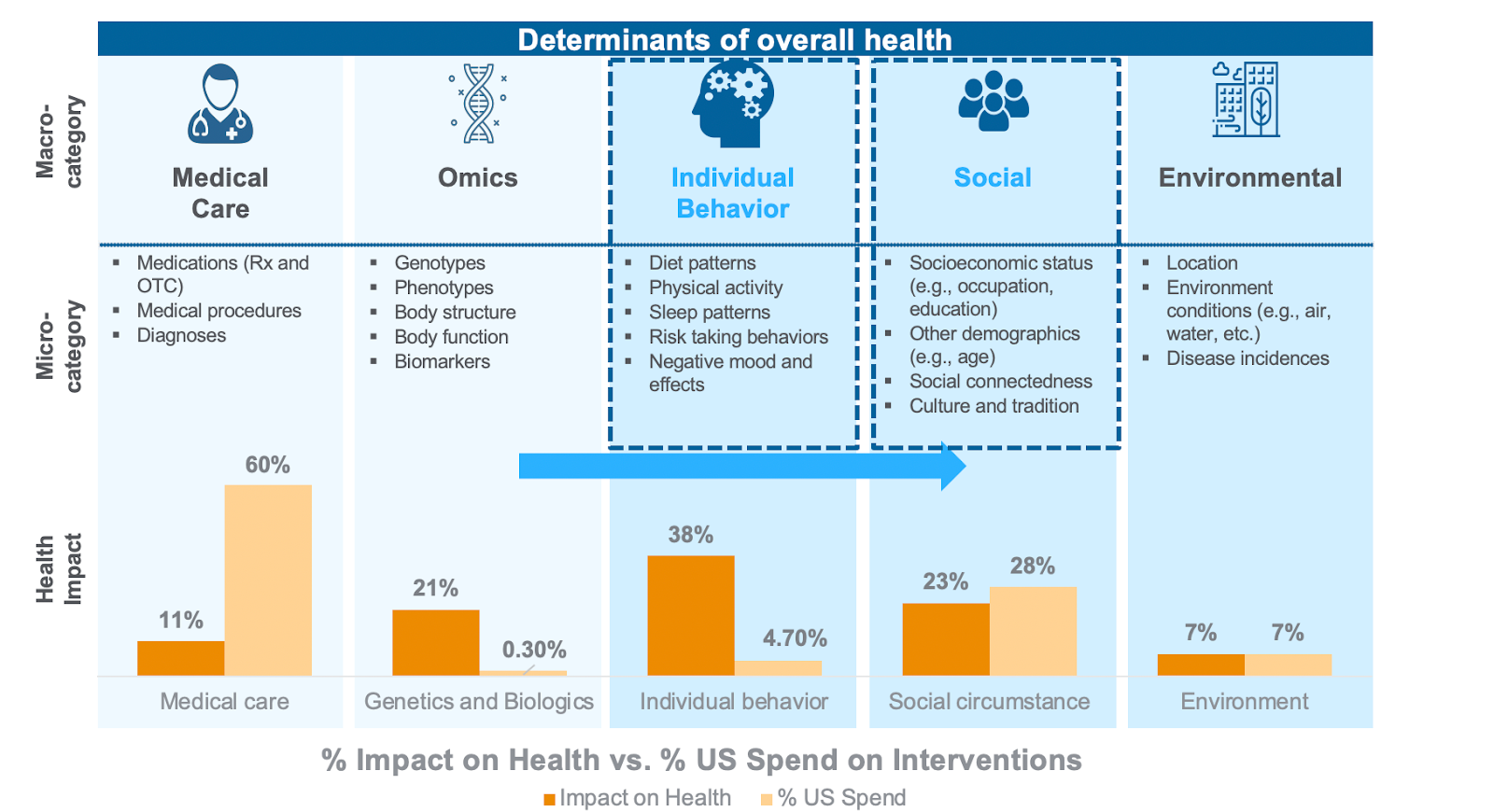At HealthXL, we are all about shared knowledge and collaboration. We worked together with one of our members, ZS Associates, to put together this blog. Special thanks to Jeff Gombala for co-authoring and Naveen Rao of Patchwise Labs for the postface.
According to the Healthy People 2020 initiative, ‘Social determinants of health are conditions in the environments in which people are born, live, learn, work, play, worship, and age that affect a wide range of health, functioning, and quality-of-life outcomes and risks.’
Political and economic forces determine people’s daily circumstances, such as access to public goods such as health care, education, transportation, work and housing. Research has estimated that a small, albeit significant, fraction of population health is shaped by medical care. Studies suggest that 80 to 90% of health outcomes are attributable to non-medical social determinants of health (SDoH). For instance, smoking, physical activity, sleep patterns, financial security, loneliness, access to transportation, culture and tradition and more have a tremendous impact on health outcomes in people’s day to day lives.

The promise of digital health and SDoH innovation
The true promise of digital health technologies is the ability to enhance our capacity to effectively prevent, diagnose, treat, and manage disease via digital technologies. The table below provides some examples of digital health interventions and their application.

There is no shortage of innovations and announcements in recent news (IPOs, funding announcements) supporting the excitement of the digital health promise. For example, in recent weeks:

Social determinants matter but who’s acting?
Physicians agree on the impact SDoH have on an individual’s health, yet many believe the responsibility lies elsewhere. The Government has meaningfully stepped up to support new market opportunities for addressing SDoH: Medicaid’s managed care markets have allotted dedicated reimbursements in North Carolina, Massachusetts, New York, California, Oregon, and a growing list of other states, while CMS expansion of supplemental benefits to address non-clinical factors will reshape the opportunity for America’s 22m seniors in Medicare Advantage plans starting in 2020.
With these new incentives in place, there is a growing opportunity for both the health insurance and pharmaceutical industries to explore strategic investments and partnerships that can improve clinical and financial outcomes:
- Virtually every major US health plan has announced new or expanded SDoH initiatives. Some of these include social needs referral platforms, such as Centene’s Social Health Bridge, Kaiser Permanente (KP) and Aetna/CVS Health’s partnerships with UniteUs, or the Blues multi-plan partnership with Solera. Both KP and UnitedHealthGroup have invested in housing for their highest-cost complex populations, while Humana’s Bold Goals initiative aims to improve health at the community level.
- Pharma will be uniquely positioned to develop and scale digital innovations addressing SDoH starting in areas such as cancer, diabetes, asthma, hypertension, and other chronic diseases where lifestyle and socioeconomic factors play key roles in determining outcomes. This may take the form of new companion apps that incorporate collection and response to day to day activities and environmental factors. New data suggest that clinical trials also need to factor in SDoH when evaluating emerging treatments.
Postface by Naveen Rao, Patchwise Labs
As digital health innovation reaches this new frontier, the biggest breakthroughs will require a transdisciplinary approach. Successful SDoH innovations will require equal parts technology and data, social science, and behavioral science if they are to create effortless, accessible, and consumer friendly technology-driven experiences.
Perhaps more than anything, meaningful social determinants strategy requires a new outlook that will no doubt prove challenging to traditional industry motivations of years past. Making long-term investments in people’s well-being will not always yield demonstrable returns to a lab value or performance metric due to the challenges of insurance churn, data collection and measurement, and the age-old issue of behavior change.
But at this early stage of adoption, those organizations willing to demonstrate creativity and proactive approaches could see the greatest reward as the market heats up for new ideas. As we prepare to enter the third decade of the 21st Century, technology will play an increasing role. Yet any solution to help people improve their health outside the doctor’s office will have to incorporate the vital aspects of humanity that have gone missing: empathy and listening in the form of needs assessments and screenings, provision of easy to access social support and responsive communication.
For Healthcare, the emerging SDoH frontier may prove to be just as much about ‘care’ as about ‘health'.
Dr. Brennan Spiegel, a physician-scientist at Cedars-Sinai Medical Center sums this up quite nicely
“Digital Health… is a social science and behavioral science. Creating the tech isn’t the hard part. The hard part is using the tech to change patient behavior. And that is really hard to do.”













.png)
